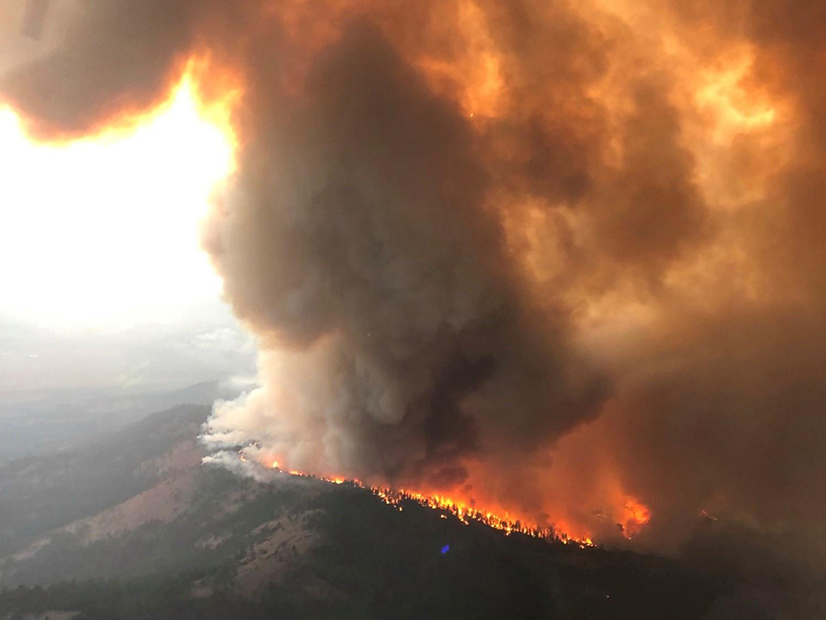
The California Public Utilities Commission on Thursday allowed Pacific Gas & Electric to exit an enhanced oversight and enforcement process the CPUC created two years ago to prevent the utility from starting catastrophic wildfires, but commissioners warned they would use the process again if needed.
Before the unanimous vote on a resolution freeing the utility from enhanced oversight, commissioners emphasized that PG&E had entered the first step of the six-step process because of particular problems with its vegetation management practices, and that it was being released because it had met specific goals imposed by the CPUC.
“This is an illustration of how the enhanced oversight and enforcement process can be effectively used,” Commissioner Clifford Rechtschaffen said. “It worked here. It’s of course not a panacea. No one is suggesting it is, but it did work. It did address an important problem. So, we should not be bashful about using it again.”
“PG&E’s operational practices remain a serious concern for us, despite everything that’s been done, so we should continue to utilize this tool,” Rechtschaffen added.
Commissioner Genevieve Shiroma said she would vote for the resolution, but “I do want to be very clear about the limited scope of this resolution and my continued concerns with PG&E’s operations.”
Other speakers noted that a number of CPUC actions targeting PG&E remain in place. They include an independent safety monitor that reports every six months on the utility operations; specific metrics to evaluate PG&E’s safety performance and to implement the enhanced oversight and enforcement (EOE) process; and continuing investigations of PG&E intended to rein in unsafe practices.
The CPUC required PG&E to accept the EOE process as a condition of it approving PG&E’s bankruptcy organization plan in June 2020.
In September of that year, a leaning gray pine fell onto a PG&E line and started the Zogg Fire in rural Northern California, killing four people and leading to additional scrutiny of PG&E’s tree clearing efforts by the CPUC and the federal judge who oversaw PG&E’s criminal probation from the 2010 San Bruno gas explosion.
The CPUC used the process for the first and only time against PG&E in April 2021, passing a resolution that said the utility was not “sufficiently prioritizing its enhanced vegetation management based on risk.”
PG&E had ranked its power lines based on wildfire risk but failed to perform the majority of its enhanced vegetation management “or even a significant portion of work” on its highest risk lines, the CPUC said at the time. The commission ordered PG&E to submit a corrective action plan and to report every 90 days on its progress clearing high-risk lines of trees and overhanging branches.
Trees and branches falling onto PG&E power lines caused devastating fires over the past five years, including last year’s nearly 1 million-acre Dixie Fire, many of the Wine Country fires of 2017 and the Zogg Fire.
The Utility Reform Network and the CPUC’s Public Advocate’s (Cal Advocates) office argued in a joint filing that the Dixie Fire and other activities warranted placing PG&E into a higher step of the EOE process, with escalating oversight and penalties.
The Dixie Fire burned for more than three months in the northern Sierra Nevada and southern Cascade ranges of California. | U.S. Forest Service
“Of particular note was PG&E’s failure to identify and remove the damaged and decayed tree” that started the Dixie Fire,” TURN and Cal Advocates said.
“When the tree fell and contacted PG&E lines, the utility demonstrated no sense of urgency despite the history of extreme fire danger and poor access in the surrounding region,” they said, citing the findings of the California Department of Forestry and Fire Protection. “PG&E’s delayed response allowed the tree to remain in contact with energized lines for approximately 10 hours and was a direct and negligent factor in the ignition of the fire.”
The CPUC decided those concerns and others were outside the bounds of the current proceeding. They found that PG&E had met the requirements of its corrective action plan and shown that it had prioritized work on high-risk lines.
“PG&E’s goal was to perform more than 80% of its [enhanced vegetation management] work in the top 20% highest risk circuit protection zones in 2021,” Thursday’s resolution said. The utility exceeded that goal by completing 98% of its tree clearing in 2021 on its highest risk lines and met other CPUC criteria, allowing to leave the EOE process, it said.

